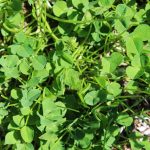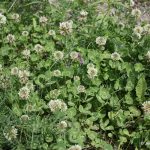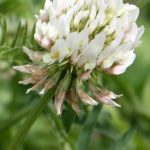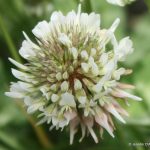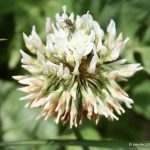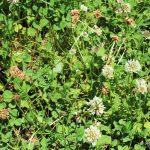White clover
Prepared by Jennifer L. D’Appollonio, Assistant Scientist, University of Maine, Orono, ME 04469. Updated April 2019.
Scientific name: Trifolium repens L.
Common name(s): white clover, Dutch clover, creeping clover
Link(s): USDA PLANTS Profile, Go Botany
Images: (to see enlargements [PC]: click on image, then right click and choose “view image”)
- developing flower
- leaflets have lighter v-shaped splotch near base
- late June
- flowers are tinged pink/cream with age
- senescing flowers
Description:
– perennial
-legume
-leaves have:
- three leaflets
- a water crest
-flower heads made of 40-100 florets
-spreads through stolons
-considered invasive in some areas
– may be confused with T. hybridum; see left sidebar on Go Botany webpage
Habitat:
-cool moist climate
-soils with lime
-shallow soils with a high water table
Agriculture:
-fixes nitrogen
-provides beneficial erosion control
-pollinated by bees and other insects
-nutritious forage species for livestock and wildlife
-typically a companion crop with forage grasses
-grazed by:
- white-footed voles, bears, moose, mule and white-tailed deer and blue grouse
-seeds are eaten by:
- northern bobwhite, bufflehead, American coot, sage grouse, ruffed grouse, sharp-tailed grouse, horned lark, mallard, gray partridge, greater prairie chicken, willow ptarmigan, American pintail, California quail and American robin.
Natural History:
-native to Europe
Source(s):
St. John, Loren, and Dan Ogle. “WHITE CLOVER.” Plant Guide, USDA NRCS, 2008, plants.usda.gov/plantguide/pdf/pg_meof.pdf.

